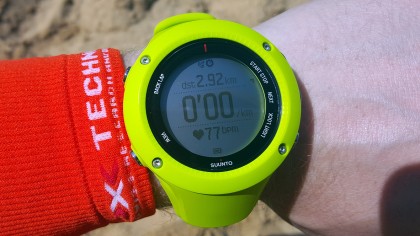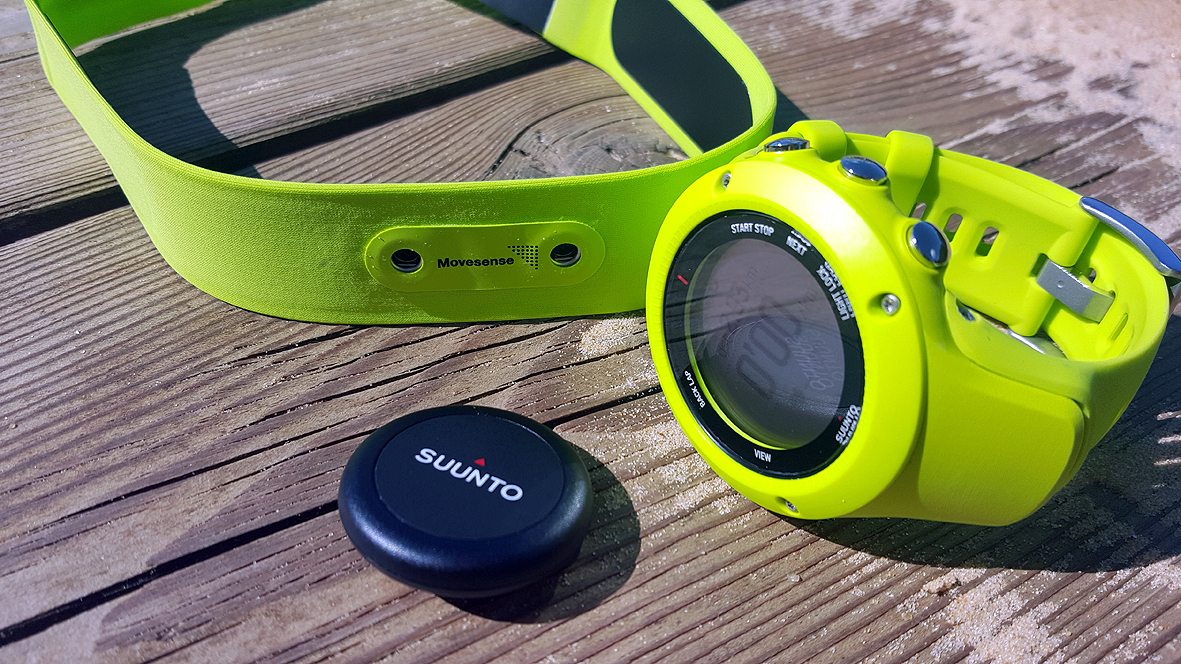TechRadar Verdict
With its off-road styling, excellent navigation and huge wealth of features, the Suunto Ambit 3 Run is a cracking trail-running watch. It is also suitable for the city, but there are better options there.
Pros
- +
Good, solid build. Decent battery life. Excellent running/navigation functionality.
Cons
- -
Quite expensive. Many will find it overly complex. Better suited to trail running than roads.
Why you can trust TechRadar
Suunto knows a thing or two about sports watches, and that's apparent in the Suunto Ambit 3 Run - which is also sometimes known as the Ambit3 Run - even Suunto's own site uses both.
[Update: The Suunto Ambit Run3 has been around for a couple of years now, and been usurped by watches likes the Suunto Spartan Trainer Wrist HR - that model is vastly more powerful and not a lot more money, so we'd recommend going for that].
Suunto has a long heritage in dive computer design and build leading it to place a premium on durability when compared with more 'lifestyle' brands such as Fitbit, Basis and TomTom. This means it tends to favour chunky 'outdoor' watches, but it also means you get a wrist guard that feels like it's capable of fighting off bears.
The Suunto Ambit 3 Run is the latest in a long line of Suunto Ambits, all waterproof to immense depths, GPS-enabled and solidly built. Suunto has begun to differentiate the various sporting uses by taking a standard Ambit 3 and removing the unnecessary bits.
In this case that means multi-sport functionality, along with swimming and cycling sensors. This may sound like a bad thing, but the slimmed-down version is much easier to navigate, and just as configurable as before.

Screen and battery life
The screen is a tried and tested monochrome dot-matrix affair, which delivers plenty of data without slurping too much battery, and there's a very effective backlight for darker conditions.
You can also flip the screen tone from black-on-white to white-on-black, depending on the conditions, which is a handy trick. The upshot is that battery life is decent – about a week in normal use. Without GPS use it'll last much longer.
Sign up for breaking news, reviews, opinion, top tech deals, and more.
Design, build quality and strap comfort
The Suunto Ambit 3 Run is the latest in a long line of Suunto Ambits, and at first glance not much has changed over the last few years. It's available with or without a separate, chest-strap heart-rate monitor – we tested the latter version.
The body of the watch is almost unchanged (apart from the introduction of a new day-glo Lime colour option; the 3 Run is also available in white and black), with a chunky bezel, a broad and generously long strap, and an extended area of the watch that contains all the antennas, GPS and so on. Charging is via a bulldog-type clip with a row of pins that locate into the bottom of the watch case, and the same cable deals with syncing/updating software.

As mentioned above, with its dive computer heritage Suunto hasn't skimped on the build quality, and although the 3 Run isn't overly heavy it's not something you'd wear casually in the office either. It's big, and makes you feel like taking on an ultra to justify the look.
The strap is big enough to buckle around the narrow end of a standard pint glass; the polished stainless buckle is a lovely bit of detailing, and adds a feeling of real quality.
The five polished stainless buttons continue that theme; this isn't a fragile, touchscreen-powered piece of tech by any means. This does mean sacrificing most of the smartwatch-type malarkey, but them's the breaks.
Running functionality
The previous Ambits were outdoor watches that could track running, but this is a more specialised tool – so what's changed? Suunto has retained much of the watch UI from previous models, so the initial layout will be familiar to many.
Tab into the activity menu – right hand 'Start' button – and you're immediately into the Suunto deck of running options, which is fairly exhaustive: trail, track, indoor and vanilla running are all present and correct.
If there's something you're missing then you can create it as a custom sport on the Suunto Movescount site, then sync it with your phone.
In keeping with Suunto's heritage, the other two options – 'run a POI' and 'run a route' – take advantage of the Ambit's GPS smarts, which enable you to create or download a running route or series of POIs from movescount.com.
When you're running a downloaded route the watch guides you on each step, issuing alerts if you're off-route.
For town running this is slight overkill, although it's handy for following green chain routes or similar, but in open country it's very handy indeed.
Sadly the Ambit 3 Run appears to have lost the 'bailout' feature of the full-fat Ambit range, although that's always been of more use to mountaineers and others in difficult, complex terrain.

Once you've picked your running choice you get two dismissible screens for HR belt pairing and GPS finding. The latter screen indicates how many satellites the watch has found, and in former models this often took a while to deliver.
The Ambit 3 has cut this time to a reliable 30 seconds, which isn't too long to be standing on the pavement, and it's easily skipped if you're freezing. Once in this mode, hit Start and you're off.
The default display breaks down to distance at the top, split time in the middle and BPM/ave distance time/cadence at the bottom of screen one, with another couple of screens displaying splits and a stopwatch a tab-right away.
These can be customised to display whatever stats you like via movescount.com, up to seven screens' worth.
One really nice feature we enjoyed is hidden in the activity tracker stats (see below): a simple recovery timer.
Like in a dive watch with its no-fly and surface timers, this plots your minimum recovery time, corrected against the severity of the workout. It's a handy reminder in a busy week, as well as a preventative step against over-training, which is arguably worse for peak performance than not training at all – especially psychologically.
Heart-rate monitor
As with the Polar M400, the Suunto Ambit 3 Run relies on a chest strap to track your heart rate, which is fair enough as it's the most accurate way of doing that outside a lab. Suunto has cunningly taken the relatively retro belt and updated it in several subtle ways, colour-coding it to the watch, and tweaking the classic hook-and-loop closure with great results.

The HR pod itself is apparently the smallest around, and it certainly is tiny, which is a USP, but we'll need longer with it to tell if the smaller size hinders use at all – at the moment, around town, it seems not to.
Accuracy is unsurprisingly good, and (without a lab test rig) we didn't spot any issues. Pairing with the watch was seamless, and there are a variety of other sensor pods that can also be paired.
App
Here be dragons. Historically, Suunto has had a pretty complex software/sync setup, and the Ambit 3 has seen some simplification of the ecosystem. Android and iOS apps are available, which enable you to sync your Ambit over Bluetooth with your movescount.com account, where your data is held.
However, try as as might we couldn't get the Android app (in open beta) to pair with the Ambit. The Apple app (on an iPad Air) did immediately. From the iOS app you can view your stats and view/create Workouts, one of Suunto's recent updates to compete with Garmin. However, updating your device firmware requires the PC or Mac app and the charging cable.

The PC and Mac apps enable you to create custom sports and routes and load POIs, as well as view and edit your stats, and export them in a range of formats.
A particularly cool function on the iOS app is the confusingly named Suunto Movie (of your Suunto Move, or session), which gives you a short shareable movie of a TV-style animated map tracking your run, with pop-out highlights like maximum HR, max cadence and so on.
It's mainly useless for data purposes, but it's fun, and very shareable if you've just completed an epic route or race.

Unsurprisingly, the iOS app just contains an overview of your stats, with a graph of pace, speed, HR and altitude, so if you want heavy data it's over to the web interface, which is considerably more serious - and has improved in UI in the subsequent years since launch.
In addition to the app stats there's cadence, EPOC, energy consumption, respiration rate, vertical speed, Vo2 and RR, which can be overlaid for full-on data meltdown.
To complete the picture there are Suunto's apps, which you can either concoct yourself or download ready-made. These are basically custom algorithms that can be very useful in specific applications – there's a marathon completion time app, for example, and a time to next POI app. These can be uploaded to your Suunto, and then added into your screen configuration as you wish.
Additional features
Under 'unexpected additions' comes an activity tracker, with a display of your inertia just one tap of the 'next' button away.
It's pretty harsh too, with a graph giving an overall impression, kcal used rating and an assessment – which we found usually hung somewhere between 'inactive' and mediocre.
There's no way to dig deeper into the stats, but at least that background activity is being factored into recovery, for example.
Verdict
The build quality of the Suunto Ambit 3 run is confidence-inspiring, and the actual data collected is impressive. There are some very nice touches in the recovery meter and the activity tracker, and we loved the movie tidbit.
The navigation functionality is among the best you can buy, and the battery life is reasonable if not stellar - but far better than something like the Apple Watch.
We disliked
The Suunto Ambit 3 Run (HR) has an RRP of £249.99/$349, and the watch without the heart rate monitor is £199.99/$299, although that's dropped a touch since then. Cheaper deals are available online, but it's still pricier than the M400 and other competitors.
Creating workouts and syncing isn't as intuitive as you'd hope, and even with the benefit of using previous Ambits we had to resort to the instructions on several occasions. It's quite bulky too – it's quite a thing to wear to the office or around town.
Final verdict
The Suunto Ambit 3 Run is big, bombproof, and very configurable, and if you're looking for a 'serious' running watch then this should be near the top of the list, along with Garmin and Polar units.
The Suunto edges ahead of the competition if you're out on the trail a lot, where its GPS smarts and navigation power are a real boon.
For urban use, it's hard to justify the size and added complexity that come with the higher price, but as an off-road running watch, this is a compelling evolution of an already proven package from Suunto.

Mark Mayne has been covering tech, gadgets and outdoor innovation for longer than he can remember. A keen climber, mountaineer and scuba diver, he is also a dedicated weather enthusiast and flapjack consumption expert.
